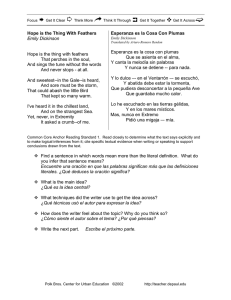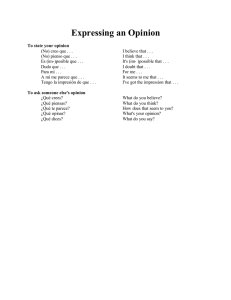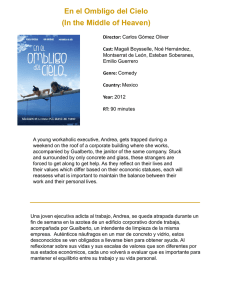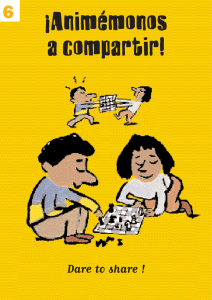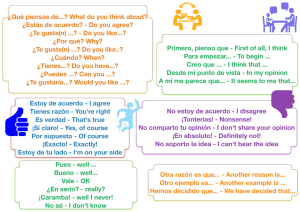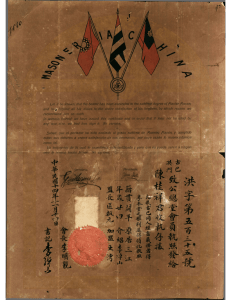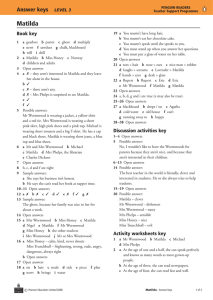Mil palabras - Houghton Mifflin Harcourt
Anuncio
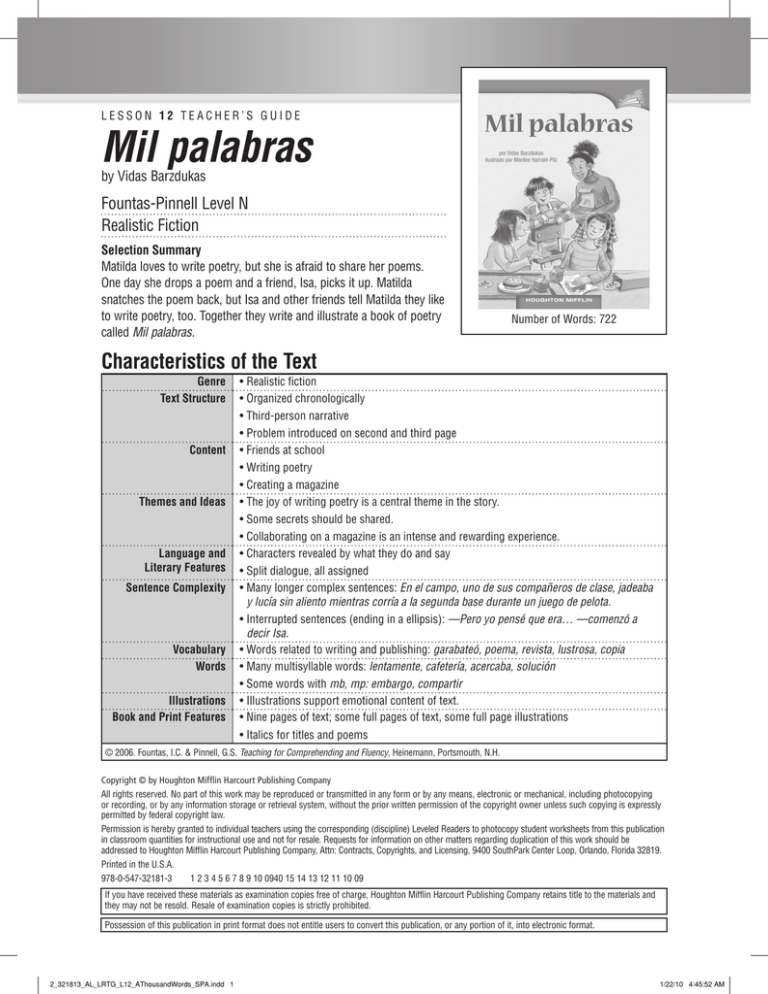
Nivel: O EDL: 34 LESSON 12 TEACHER’S GUIDE Mil palabras by Vidas Barzdukas Género: Ficción realista Estrategia: Preguntar Destreza: Estructura del cuento Número de palabras: 712 por Vidas Barzdukas ilustrado por Marilee Harrald-Pilz 2.3.2 Fountas-Pinnell Level N Realistic Fiction HOUGHTON MIFFLIN Libritos nivelados en línea Selection Summary Matilda loves to write poetry, but she is afraid to share her poems. One day she drops a poem and a friend, Isa, picks it up. Matilda snatches the poem back, but Isa and other friends tell Matilda they like to write poetry, too. Together they write and illustrate a book of poetry called Mil palabras. 1033785 2_018966_LR3_2AL_COVER_SPA_mil_p1 1 H O U G H T O N MI F F L I N Number of Words: 722 4/14/08 10:43:26 AM Characteristics of the Text Genre Text Structure Content Themes and Ideas Language and Literary Features Sentence Complexity Vocabulary Words Illustrations Book and Print Features • Realistic fiction • Organized chronologically • Third-person narrative • Problem introduced on second and third page • Friends at school • Writing poetry • Creating a magazine • The joy of writing poetry is a central theme in the story. • Some secrets should be shared. • Collaborating on a magazine is an intense and rewarding experience. • Characters revealed by what they do and say • Split dialogue, all assigned • Many longer complex sentences: En el campo, uno de sus compañeros de clase, jadeaba y lucía sin aliento mientras corría a la segunda base durante un juego de pelota. • Interrupted sentences (ending in a ellipsis): —Pero yo pensé que era… —comenzó a decir Isa. • Words related to writing and publishing: garabateó, poema, revista, lustrosa, copia • Many multisyllable words: lentamente, cafetería, acercaba, solución • Some words with mb, mp: embargo, compartir • Illustrations support emotional content of text. • Nine pages of text; some full pages of text, some full page illustrations • Italics for titles and poems © 2006. Fountas, I.C. & Pinnell, G.S. Teaching for Comprehending and Fluency, Heinemann, Portsmouth, N.H. Copyright © by Houghton Mifflin Harcourt Publishing Company All rights reserved. No part of this work may be reproduced or transmitted in any form or by any means, electronic or mechanical, including photocopying or recording, or by any information storage or retrieval system, without the prior written permission of the copyright owner unless such copying is expressly permitted by federal copyright law. Permission is hereby granted to individual teachers using the corresponding (discipline) Leveled Readers to photocopy student worksheets from this publication in classroom quantities for instructional use and not for resale. Requests for information on other matters regarding duplication of this work should be addressed to Houghton Mifflin Harcourt Publishing Company, Attn: Contracts, Copyrights, and Licensing, 9400 SouthPark Center Loop, Orlando, Florida 32819. Printed in the U.S.A. 978-0-547-32181-3 1 2 3 4 5 6 7 8 9 10 0940 15 14 13 12 11 10 09 If you have received these materials as examination copies free of charge, Houghton Mifflin Harcourt Publishing Company retains title to the materials and they may not be resold. Resale of examination copies is strictly prohibited. Possession of this publication in print format does not entitle users to convert this publication, or any portion of it, into electronic format. 2_321813_AL_LRTG_L12_AThousandWords_SPA.indd 1 1/22/10 4:45:52 AM Mil palabras by Vidas Barzdukas Build Background Help children use their experience as writers to visualize this story. Build interest by asking a question such as the following: ¿Qué les gusta escribir? Read the title and author and talk about the cover illustration. Point out that the story is realistic fiction, so the characters will probably act like real people. Introduce the Text Guide children through the text, noting important ideas and helping with unfamiliar language and vocabulary so they can read the text successfully. Here are some suggestions: Page 2: Explain that this is a story about Matilda, who loves to write poetry. Suggested language: Vayan a la página 4. Leamos la primera oración del último párrafo: Sin embargo Matilda nunca compartía sus poemas con nadie. ¿Por qué querría Matilda mantener sus poemas en secreto? Page 6: Draw attention to the illustration. A Matilda se le cae un poema y su amiga Isa lo recoge y lo lee. ¿Qué les dice esta imagen acerca de cómo se siente Matilda cuando Isa lee su poema? ¿Cómo lo saben? Page 8: Draw attention to the highlighted word, acercaba: Matilda estaba comiendo sola cuando vio que Isa y otros amigos se acercaban. ¿Por qué piensan que Matilda estaba comiendo sola? Page 9: Los amigos de Matilda le dicen que piensan que es una buena escritora. ¡Matilda está asombrada! ¿Por qué creen que está tan sorprendida? Page 13: Draw attention to the highlighted words: negociar and solución. Cuando negocias una solución para un problema, tienes que hablar para llegar a un acuerdo. Ahora, vuelvan al comienzo del cuento para descubrir qué sucede con Matilda y sus poemas. Expand Your Vocabulary acercaba – llegar más cerca, p. 8 asombrada – sentir sorpresa o incredulidad, p. 9 Grade 2 jadeaba – respiraba con dificultad, p. 2 solución – la respuesta a un problema, p.13 negociar – hablar con alguien para llegar a un acuerdo, p. 13 2 Lesson 12: Mil palabras © Houghton Mifflin Harcourt Publishing Company 2_321813_AL_LRTG_L12_AThousandWords_SPA.indd 2 1/22/10 4:45:52 AM Read Have children read Mil palabras silently while you listen to individual children read. Support their problem solving and fluency as needed. Remind children to use the Question Strategy questions about what they are reading. , and to think of Discuss and Revisit the Text Personal Response Invite children to share their personal responses to the story. Suggested language: ¿Creen que Matilda compartirá sus poemas de ahora en adelante? ¿Por qué sí? ¿Por qué no? Ways of Thinking As you discuss the text, help children understand these points: Thinking Within the Text Thinking Beyond the Text Thinking About the Text • Matilda loves to write poetry, but she is afraid to share it. • Writing doesn’t have to be a solitary activity. • The language sounds realistic, the way real people talk. • She is upset when friends see her poetry, until they tell her how much they like it. • Fear of being laughed at can inhibit friendship and communication. • The author uses sensory details to show what Matilda notices as a poet. • Matilda and her friends write and illustrate a book of poems together. • Working together brings satisfaction. • The author creates a full picture of Matilda through her actions and her written and spoken words. • Poetry is a form of communication. © 2006. Fountas, I.C. & Pinnell, G.S. Teaching for Comprehending and Fluency, Heinemann, Portsmouth, N.H. Choices for Further Support • Fluency Invite children to choose a passage from the text to read aloud. Remind them to use expression to show the meaning of the text, especially Matilda’s feelings. • Comprehension Based on your observations of the children’s reading and discussion, revisit parts of the text to clarify or extend comprehension. Remind children to go back to the text to support their ideas. • Phonics/Word Work Provide practice as needed with words and word parts, using examples from the text. Have children take apart and read words using open (ending in a vowel, as in se-cre-to and po-e-mas, page 4) and closed (ending in a consonant, as in com-par-ti-do, page 10) syllables. Grade 2 3 Lesson 12: Mil palabras © Houghton Mifflin Harcourt Publishing Company 2_321813_AL_LRTG_L12_AThousandWords_SPA.indd 3 1/22/10 4:45:53 AM Writing about Reading Critical Thinking Have children complete the questions on Hoja reproducible 12.8. Responding Have children complete the activities at the back of the book. Use the instruction below as needed to reinforce or extend understanding of the comprehension skill. Target Comprehension Skill Story Structure Remind children to think about the setting, characters, and plot in a story. Model the skill, using a “Think Aloud” like the one below: Think Aloud Puedo comprender la trama del cuento cuando pienso en qué hacen los personajes. El personaje principal, Matilda, tiene miedo de compartir sus poemas. Los demás personajes, Isa, Juan y Alicia, ayudan a Matilda diciéndole cuánto les gustan sus poemas. Juntos escriben e ilustran una revista de poesía. Hacia el final del cuento, Matilda se da cuenta de que le gusta compartir sus poemas. Practice the Skill Have children write three sentences about what the characters do in another book they have read. Writing Prompt: Thinking Beyond the Text Have children write a response to the prompt on page 6. Remind them that when they think beyond the text, they use what they know and their own experience to think about what the characters do and why they act as they do. Assessment Prompts • What will Matilda probably do the next time she writes a poem? • What does the word asombrada mean in the sentence on page 9? Grade 2 4 Lesson 12: Mil palabras © Houghton Mifflin Harcourt Publishing Company 2_321813_AL_LRTG_L12_AThousandWords_SPA.indd 4 1/22/10 4:45:53 AM Responder DESTREZA CLAVE Estructura del cuento ¿Qué sucede en el cuento? ¿Cuál es el problema? ¿Cómo se solucionó el problema? Copia el recuadro de abajo. Escribe el problema, los sucesos y las soluciones en los cuadros. Problema Matilda tenía miedo de compartir sus poemas. Solución ¿? Sucesos ¿? ¡A escribir! El texto y tú A Matilda le encanta la poesía. ¿Qué te gusta leer a ti? Escribe un párrafo acerca de lo que te gusta leer. Asegúrate de explicar por qué piensas así. Lección 12 HOJA REPRODUCIBLE 12.8 Fecha Nombre Piénsalo 15 Mil palabras Piénsalo Lee y contesta las preguntas. 1. ¿Por qué Matilda le arranca el papel a Isa? 2_035840_LR3_2AL_MILPAL_L12.indd15 15 11/19/09 2:38:18 PM No quiere que ella lea su poema. 2. ¿Por qué crees que la revista se llama “Mil palabras”? Respuesta posible: Creo que se llama “Mil palabras” porque contiene muchas palabras. 3. A Matilda le gusta escribir poemas. ¿Qué otras cosas podría escribir? Las respuestas variarán. Hacer conexiones Matilda se da cuenta de que es mejor compartir su secreto con sus amigos. ¿Tienes tú algún secreto que quisieras compartir? ¿A quién le contarías tu secreto? ¿Por qué? Escribe tu respuesta en tu Cuaderno de lectura. Lea las instrucciones a los niños. Piénsalo 10 Grado 2, Unidad 3: Dímelo a mí © Houghton Mifflin Harcourt Publishing Company. All rights reserved. 2_352893RTXSAN_U03_LR_CT.indd 10 Grade 2 5 8/12/09 7:34:44 PM Lesson 12: Mil palabras © Houghton Mifflin Harcourt Publishing Company 2_321813_AL_LRTG_L12_AThousandWords_SPA.indd 5 1/22/10 4:45:55 AM Nombre Fecha Mil palabras Pensar más alla del texto Lee el párrafo. Después, escribe la entrada en tu diario en el espacio en blanco. Imagina que eres Matilda. Escribe una entrada en tu diario. Explica cómo ha cambiado lo que sientes acerca de compartir tus poemas. Explica por qué pasó esto. Grade 2 6 Lesson 12: Mil palabras © Houghton Mifflin Harcourt Publishing Company 2_321813_AL_LRTG_L12_AThousandWords_SPA.indd 6 1/22/10 4:45:57 AM Lección 12 Nombre Fecha HOJA REPRODUCIBLE 12.8 Piénsalo Mil palabras Piénsalo Lee y contesta las preguntas. 1. ¿Por qué Matilda le arranca el papel a Isa? 2. ¿Por qué crees que la revista se llama “Mil palabras”? 3. A Matilda le gusta escribir poemas. ¿Qué otras cosas podría escribir? Hacer conexiones Matilda se da cuenta de que es mejor compartir su secreto con sus amigos. ¿Tienes tú algún secreto que quisieras compartir? ¿A quién le contarías tu secreto? ¿Por qué? Escribe tu respuesta en tu Cuaderno de lectura. Grade 2 7 Lesson 12: Mil palabras © Houghton Mifflin Harcourt Publishing Company 2_321813_AL_LRTG_L12_AThousandWords_SPA.indd 7 1/22/10 4:45:58 AM Lección 12 Estudiante HOJA REPRODUCIBLE 12.11 Fecha Mil palabras Mil palabras Registro de lectura NIVEL N page 2 Selection Text Errors Self-Corrections Accuracy Rate Total SelfCorrections Matilda se recostó en un roble muy pensativa. En el campo, uno de sus compañeros de clase jadeaba y lucía sin aliento mientras corría a la segunda base durante un juego de pelota. Matilda apenas lo notó. Ella estaba ocupada observando un pájaro en el cielo. Luego, garabateó en su libreta: Azulejo, azulejo Tan alto en el cielo. ¿Adónde vas? ¿Adónde volarás? Matilda sonrió. Le encantaba escribir poesía. Le encantaba la forma en que las palabras fluían de su mente a la página a cualquier hora. Comments: (# words read correctly/86 × 100) lobo Repeated word, sentence, or phrase ® Omission lobo lobo Grade 2 0 0 1 8 Substitution Code lodo lobo 1 Self-corrects lodo sc lobo 0 Insertion el 1 Word told T lobo lobo Error 1 1416027 ✓ Behavior Error 9 7 805 4 7 3 2 1 8 1 3 Read word correctly Code 90000 Behavior ISBN-13: 978-0-547-32181-3 ISBN-10: 0-547-32181-3 % Lesson 12: Mil palabras © Houghton Mifflin Harcourt Publishing Company 2_321813_AL_LRTG_L12_AThousandWords_SPA.indd 8 1/22/10 4:45:58 AM
